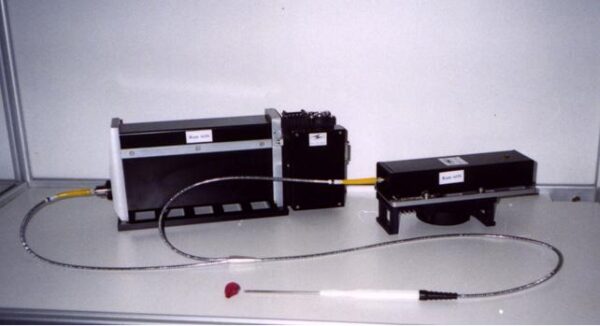Application
Contactless spectral chemical characterization of samples: express-analysis on site. Spectrometer can be used as a portable instrument for out-of-door researches and measurements.
Specific features
- Small sizes and weight, compactness
- Rugged, modular design
- Fiber-optic probe
- Double monochromator
- High optical throughput
- Spectral agility
- Programmable operation modes
Technical characteristics
- Operation range: 100 — 5000 cm-1.
- Spectral resolution 9 cm-1 (0,4 nm at 0,63 mcm).
- Spectral range 0,52 – 0,89 mcm.
- Input aperture Æ9 mm ´ 4°.
- Solid-state laser 532 nm, 0,2 W, CW.
- Diode laser 780 nm, 0,1 W, CW.
- Photomultiplier “Hamamatzu R-2929”
Sizes and weight
- Optical unit 40*10*16 cm3 3 kg
- Control unit 36*12*5 cm3 2 kg
- Solid-state laser 25*10*9 cm3 2 kg
- Power supply 25*19*9 cm3 2 kg
- Diode laser 10*8*4 cm3 0,2 kg
- Fiber-optic probe 1,5 m
Brief description
A complete analytic system comprises acousto-optical spectrometer, compact CW diode pumped frequency doubled solid state laser (532 nm) and fiber optic probe. Small-size diode laser at 785 nm is optional. The spectrometer consists of compact optical unit and small-size control unit. Optical unit contains double AOTF monochromator, and driving radiofrequency elements for AOTFs tuning. There is a compartment for notch filter at 532 nm or at 785 nm.
The key element of the spectrometer is a pair of acousto-optical tunable filters (AOTF). Each AOTF contains a birefringent crystal, in which the volume phase grating is generated by ultrasound wave via elasto-optic effect. The grating diffracts that spectral component of input optical radiation, which corresponds to grating period. AOTF also comprises input and output crossed polarizers for diffracted component separation. To tune AOTF over spectrum it is sufficient to change the frequency of signal supplied to the acoustic source. Double monochromator ensures high out-of-band radiation suppression.
The spectrometer is programmable and allows short-time random spectral access. A modulation mode operation ensures high signal-to-noise ratio. Spectrometer is controlled from any computer via serial port. Device can be used as a separate computer-controlled spectrometric instrument or as well as be incorporated in industrial control systems.

